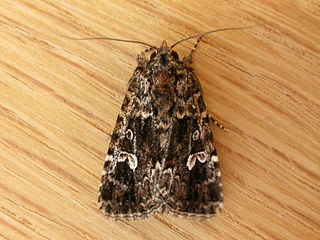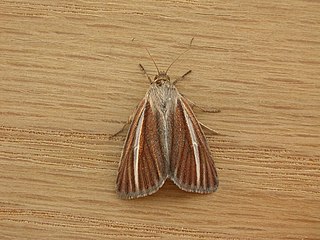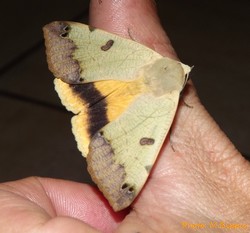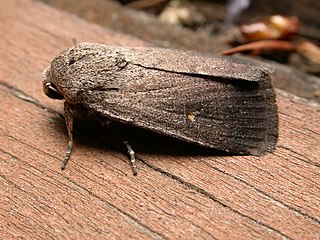| Saroba | |
|---|---|
 | |
| Scientific classification | |
| Kingdom: | |
| Phylum: | |
| Class: | |
| Order: | |
| Family: | |
| Genus: | Saroba Walker, 1865 |
Saroba is a genus of moths of the family Noctuidae.
| Saroba | |
|---|---|
 | |
| Scientific classification | |
| Kingdom: | |
| Phylum: | |
| Class: | |
| Order: | |
| Family: | |
| Genus: | Saroba Walker, 1865 |
Saroba is a genus of moths of the family Noctuidae.
Palpi sickle shaped, where the second joint reaching above vertex of head and tapering to extremity. Third joint long. Antennae ciliated in male. Thorax and abdomen smoothly scaled. Tibia moderately hairy. Forewings with nearly rectangular apex. Hindwings with usually truncate anal angle. Vein 5 from below middle of discocellular. [1]

Heliothis is a genus of moths in the family Noctuidae. It was first described by Ferdinand Ochsenheimer in 1816. Some of the species have larvae which are agricultural pests on crop species such as tobacco, cotton, soybean and pigeon pea. Some species originally in this genus have been moved to other genera, see Chloridea and Helicoverpa.

Agrotis is a genus of moths of the family Noctuidae. The genus was erected by Ferdinand Ochsenheimer in 1816. A number of the species of this genus are extinct.

The Calpinae are a subfamily of moths in the family Erebidae described by Jean Baptiste Boisduval in 1840. This subfamily includes many species of moths that have a pointed and barbed proboscis adapted to piercing the skins of fruit to feed on juice, and in the case of the several Calyptra species of vampire moths, to piercing the skins of mammals to feed on blood. The subfamily contains some large moths with wingspans longer than 5 cm (2 in).

Acantholipes is a genus of moths in the family Erebidae erected by Julius Lederer in 1857.

Avitta is a genus of moths of the family Noctuidae described by Francis Walker in 1858.
Zurobata is a genus of moths of the family Erebidae. The genus was erected by Francis Walker in 1866.

Dactyloplusia is a monotypic moth genus of the family Noctuidae erected by Chou Io and Lu Chinsheng in 1979. Its single species, Dactyloplusia impulsa, was first described by Francis Walker in 1865. It is found in Sri Lanka, India, southern China, Sundaland, Sulawesi, New Guinea, Fiji and Australia.

Ectopatria is a genus of moths of the family Noctuidae. The genus was erected by George Hampson in 1903.

Elusa is a genus of moths of the family Noctuidae erected by Francis Walker in 1859.
Erocha is a genus of moths of the family Noctuidae. The genus was erected by Francis Walker in 1854.

Euxoa is a genus of moths of the family Noctuidae raised to Genus by the German entomologist, Jacob Hübner. The Genus is mostly confined to dry and semi dry areas in the Northern Hemisphere. There 130 species in Eurasia, a few in Africa, and 175 in North America. There are no species in the Genus in South-East Asia or in Australia. In North America, most species are found in Western regions. Of the North American species, 4 are endemic to Mexico. There is one species recorded from Chile, but this may be a mislabeled specimen. In real terms, species numbers do not equal species abundance. Some areas with few species have large numbers of the ones that do live there.

Heliocheilus is a genus of moths of the family Noctuidae. Former synonyms include Canthylidia.

Lophoruza is a genus of moths of the family Noctuidae. The genus was erected by George Hampson in 1910.

Meterana is a genus of moths of the family Noctuidae. This genus is endemic to New Zealand.
Naranga is a genus of moths of the family Noctuidae.

Ophiusa is a genus of moths in the family Erebidae erected by Ferdinand Ochsenheimer in 1816.

Proteuxoa is a genus of moths of the family Noctuidae. The genus was erected by George Hampson in 1903.

Sphetta is a genus of moths of the family Noctuidae first described by Francis Walker in 1865.
Saroba maculicosta is a moth of the family Noctuidae first described by Francis Walker in 1865. It is found in Sundaland, the Philippines, Papuan region to Solomon Islands and Sri Lanka.